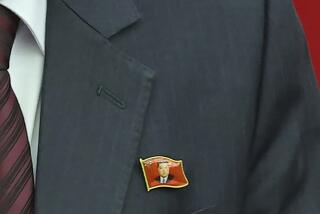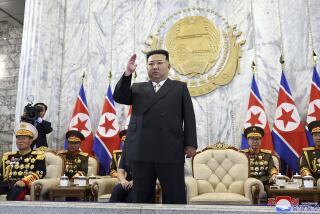North Korean Youngsters Do Political Gymnastics
- Share via
PYONGYANG, North Korea — Thousands of North Korean children move their arms and legs in perfect unison, leaving the impression that they are smiling robots created to dance and sing.
North Koreans boast that it takes only a few months to teach the 100,000 students to perform in the massive propaganda spectacle known as a “mass game.” But most of the children start learning their skills from a young age, as part of their indoctrination into the regime’s cult of personality focusing on the late ruler, Kim Il Sung.
This year’s show, which has been staged six times a week since Aug. 15, is the largest in three years -- raising speculation that it may indicate a major policy announcement, such as the naming of a successor to the current leader, Kim Jong Il.
The North Korean leader, Kim Il Sung’s son, attended a special performance Oct. 9 on the eve of the 60th anniversary of the founding of the ruling Workers’ Party. The massive celebrations in Pyongyang, the capital, also included a military parade the next day with thousands of soldiers.
The mass games are drawing the attention of tourists, who have been offered a rare opportunity to attend, apparently as a moneymaking venture. Tickets for the event run from $60 to $360, in addition to travel and hotel fees.
Hundreds of South Koreans have taken one-night trips on charter flights to Pyongyang this month, and even American tourists have been allowed into the country to view the shows on brief tours organized by a Beijing-based travel firm.
The show is likely to be extended to the end of the month because of high demand from foreign tourists, said Hyun Yung Ae, an official with the organization committee.
“There is no word to describe the performance. You have to see it to feel the grandness,” Hyun said.
“It is amazing to see our students learn to perform so well in such a short period of time,” she said, adding that the youngsters had practiced “just a few hours in the afternoon” since April.
Across Pyongyang, “art centers” teach students between the ages of 5 and 17 the techniques that are part of the show.
At Mankyongdae Children’s Palace, the biggest such center in the capital, dance teacher Kim Sung Hee says more than 5,000 students attend after-school classes daily in art, sports, science and computers.
“Children learn a subject of their own choice ... under the guidance of our great leader,” she said. “In our country, children are kings.”
As South Korean tourists entered each classroom, groups of 20 students dutifully performed their specialties -- playing the 12-stringed traditional Korean harp or the accordion -- without a single wrong note.
“These children are great, great art performers,” said Shin Young Kyo, a retired conductor for a children’s choir in South Korea. “But they are too good, I feel like I have just watched a group of machines.... Their performance doesn’t have a touch of humanity.”
At the shows, thousands of performers paraded across the stadium during the 80-minute pageant -- dancing, singing and forming shapes ranging from waves and blooming flowers to the North Korean flag and a unified Korea.
The performance, largely aimed at inspiring loyalty to the Kim dynasty, tells how Kim Il Sung built the “socialist paradise” after the Korean War.
On one side of the stadium were changing pictures so detailed that it was hard to believe they were formed by children turning colored pages in books. The mosaics depicted the party flag and Kim Il Sung’s face, with the slogan “Let’s open the door to unification with our people’s own hands.”
In one scene, performers dressed in North Korea’s brown military uniforms marched with a giant “flag of the supreme commander” -- a reference to Kim Jong Il’s role as head of the military -- against the backdrop of mosaics that read, “No one can beat us.”
In other scenes, performers swung in the air on bars and did multiple back and front flips. Some jumped rope while doing acrobatics, and others stood on top of one another to build huge towers.
“I am truly shocked. Who would have known humans are capable of these things?” said Lee Won Tae, 69, a South Korean tourist. “Only a country like North Korea can pull off something like this.”
More to Read
Sign up for Essential California
The most important California stories and recommendations in your inbox every morning.
You may occasionally receive promotional content from the Los Angeles Times.













